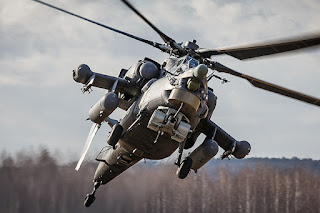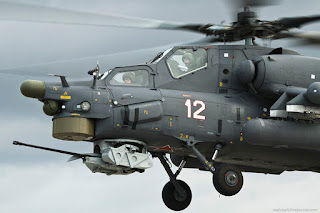The Mil Mi-28 (NATO reporting name "Havoc") is a Russian all-weather, day-night, military tandem, two-seat anti-armor attack helicopter. It is an attack helicopter with no intended secondary transport capability, better optimized than the Mil Mi-24 gunship for the role. It carries a single gun in an undernose barbette, plus external loads carried on pylons beneath stub wings.
 The Mi-28 is a new-generation attack helicopter that functions as an air-to-air and air-to-ground partner for the Mi-24 Hind and Ka-50 Hokum. The five-blade main rotor is mounted above the body midsection, short, wide, tapered, weapon-carrying wings are mounted to the rear of the body midsection. Two turboshaft engines in pods are mounted alongside the top of the fuselage with downturned exhausts. The fuselage is slender and tapers to the tail boom and nose. It features tandem, stepped-up cockpits, a cannon mounted beneath the belly, and a non-retractable tricycle tail-wheel type landing gear. Due to the energy-absorbing landing gear and seats the crew can survive a vertical fall of up to 12 m/s. The Mi-28 has a fully armoured cabin, including the windshield, which withstands 7.62 and 12.7 mm armor piercing bullets and 20 mm shell fragments.
The Mi-28 is a new-generation attack helicopter that functions as an air-to-air and air-to-ground partner for the Mi-24 Hind and Ka-50 Hokum. The five-blade main rotor is mounted above the body midsection, short, wide, tapered, weapon-carrying wings are mounted to the rear of the body midsection. Two turboshaft engines in pods are mounted alongside the top of the fuselage with downturned exhausts. The fuselage is slender and tapers to the tail boom and nose. It features tandem, stepped-up cockpits, a cannon mounted beneath the belly, and a non-retractable tricycle tail-wheel type landing gear. Due to the energy-absorbing landing gear and seats the crew can survive a vertical fall of up to 12 m/s. The Mi-28 has a fully armoured cabin, including the windshield, which withstands 7.62 and 12.7 mm armor piercing bullets and 20 mm shell fragments.
The helicopter design is based on the conventional pod and boom configuration, with a tail rotor. The main rotor head has elastomeric bearings and the main rotor blades are made from composite materials. The tail rotor is designed on a biplane configuration, with independently controlled X-shaped blades. A new design of all-plastic rotor blades, which can sustain 30 mm shells, is installed on the Mi-28N night attack variant.
 It is equipped with two heavily armored cockpits, a windshield able to withstand 12.7–14.5 mm caliber bullets, in-nose electronics, and a narrow-X tail rotor (55 deg), with reduced noise characteristics. It is powered by two 2,200 hp Isotov TV-3-117VM (t/n 014) turboshaft engines.
It is equipped with two heavily armored cockpits, a windshield able to withstand 12.7–14.5 mm caliber bullets, in-nose electronics, and a narrow-X tail rotor (55 deg), with reduced noise characteristics. It is powered by two 2,200 hp Isotov TV-3-117VM (t/n 014) turboshaft engines.
While the Mi-28 is not intended for use as a transport, it does have a small passenger compartment capable of carrying three people. The planned purpose of this is the rescue of downed helicopter crews.
The Mi-28N features a helmet mounted display for the pilot. The pilot designates targets for the navigator/weapons officer, who proceeds to fire the weapons required to fulfill that particular task. The integrated surveillance and fire control system has two optical channels providing wide and narrow fields of view, a narrow-field-of-view optical television channel, and laser rangefinder. The system can move within 110 degrees in azimuth and from +13 to −40 degrees in elevation.
The night attack variant helicopter retains most of the structural design of the original Mi-28. The main difference is the installation of an integrated electronic combat system. Other modifications include: new main gearbox for transmitting higher power to the rotor, new high-efficiency blades with swept-shaped tips, and an engine fuel injection control. More details
 The Mi-28 is a new-generation attack helicopter that functions as an air-to-air and air-to-ground partner for the Mi-24 Hind and Ka-50 Hokum. The five-blade main rotor is mounted above the body midsection, short, wide, tapered, weapon-carrying wings are mounted to the rear of the body midsection. Two turboshaft engines in pods are mounted alongside the top of the fuselage with downturned exhausts. The fuselage is slender and tapers to the tail boom and nose. It features tandem, stepped-up cockpits, a cannon mounted beneath the belly, and a non-retractable tricycle tail-wheel type landing gear. Due to the energy-absorbing landing gear and seats the crew can survive a vertical fall of up to 12 m/s. The Mi-28 has a fully armoured cabin, including the windshield, which withstands 7.62 and 12.7 mm armor piercing bullets and 20 mm shell fragments.
The Mi-28 is a new-generation attack helicopter that functions as an air-to-air and air-to-ground partner for the Mi-24 Hind and Ka-50 Hokum. The five-blade main rotor is mounted above the body midsection, short, wide, tapered, weapon-carrying wings are mounted to the rear of the body midsection. Two turboshaft engines in pods are mounted alongside the top of the fuselage with downturned exhausts. The fuselage is slender and tapers to the tail boom and nose. It features tandem, stepped-up cockpits, a cannon mounted beneath the belly, and a non-retractable tricycle tail-wheel type landing gear. Due to the energy-absorbing landing gear and seats the crew can survive a vertical fall of up to 12 m/s. The Mi-28 has a fully armoured cabin, including the windshield, which withstands 7.62 and 12.7 mm armor piercing bullets and 20 mm shell fragments.The helicopter design is based on the conventional pod and boom configuration, with a tail rotor. The main rotor head has elastomeric bearings and the main rotor blades are made from composite materials. The tail rotor is designed on a biplane configuration, with independently controlled X-shaped blades. A new design of all-plastic rotor blades, which can sustain 30 mm shells, is installed on the Mi-28N night attack variant.
 It is equipped with two heavily armored cockpits, a windshield able to withstand 12.7–14.5 mm caliber bullets, in-nose electronics, and a narrow-X tail rotor (55 deg), with reduced noise characteristics. It is powered by two 2,200 hp Isotov TV-3-117VM (t/n 014) turboshaft engines.
It is equipped with two heavily armored cockpits, a windshield able to withstand 12.7–14.5 mm caliber bullets, in-nose electronics, and a narrow-X tail rotor (55 deg), with reduced noise characteristics. It is powered by two 2,200 hp Isotov TV-3-117VM (t/n 014) turboshaft engines.While the Mi-28 is not intended for use as a transport, it does have a small passenger compartment capable of carrying three people. The planned purpose of this is the rescue of downed helicopter crews.
The Mi-28N features a helmet mounted display for the pilot. The pilot designates targets for the navigator/weapons officer, who proceeds to fire the weapons required to fulfill that particular task. The integrated surveillance and fire control system has two optical channels providing wide and narrow fields of view, a narrow-field-of-view optical television channel, and laser rangefinder. The system can move within 110 degrees in azimuth and from +13 to −40 degrees in elevation.
The night attack variant helicopter retains most of the structural design of the original Mi-28. The main difference is the installation of an integrated electronic combat system. Other modifications include: new main gearbox for transmitting higher power to the rotor, new high-efficiency blades with swept-shaped tips, and an engine fuel injection control. More details